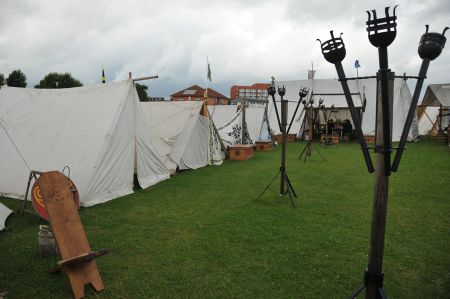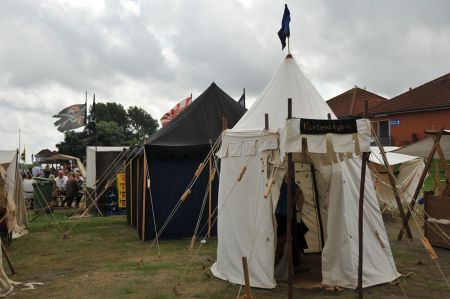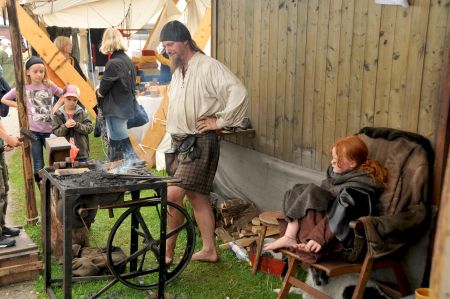We were happy to accept the invitation from Wangerland in the north of Germany, as the focus of the visit should be the medieval festival on the beach of the North Sea resort of Schillig - Horumersiel.
Schillig is a seaside resort in the municipality of Wangerland in the Friesland district of Lower Saxony. It is part of the Horumersiel-Schillig district and is located on the extreme north-eastern tip of the East Frisian peninsula. The place is about 20 kilometers north of Wilhelmshaven, two kilometers north of Horumersiel and four kilometers east of Minsen. Upstream are the islands of Wangerooge, Mellum and Minsener Oog, where we had already undertaken an interesting mudflat hike last year.
Stop and go cost 35 minutes in a mammoth traffic jam
 So we set off early on Saturday morning via Würzburg, Kassel, Hanover and Bremen. The only annoyance on the route was the major construction site near Hanover - Buchholz, which cost 35 minutes in the mammoth traffic jam due to stop and go. It is not only the time of each individual that is lost, but above all it is the thousands of vehicles that are forced to accelerate and brake pointlessly. It will always remain a mystery to us why people don't work in shifts around the clock on such construction sites, where bridge renovations had become necessary, in order to drastically reduce construction site times. From an economic point of view, it is not only the construction costs that are so immensely expensive, it is above all the vast amounts of fuel and working hours of the commuters that certainly have a much greater impact.
So we set off early on Saturday morning via Würzburg, Kassel, Hanover and Bremen. The only annoyance on the route was the major construction site near Hanover - Buchholz, which cost 35 minutes in the mammoth traffic jam due to stop and go. It is not only the time of each individual that is lost, but above all it is the thousands of vehicles that are forced to accelerate and brake pointlessly. It will always remain a mystery to us why people don't work in shifts around the clock on such construction sites, where bridge renovations had become necessary, in order to drastically reduce construction site times. From an economic point of view, it is not only the construction costs that are so immensely expensive, it is above all the vast amounts of fuel and working hours of the commuters that certainly have a much greater impact.
Fine drops of mead and wine
 Fortunately, after the turnoff in the direction of Bremen, the slow-moving traffic cleared up again, so that we were now moving quickly. Up to Horumersiel - Schillig there were no further delays, so we drove straight to the town center. Every summer, when the largest campsite in Germany is well booked, the Medieval Festival Spectaculum takes place directly on the Schillig beach. On an area of approx. 14 hectares, directly behind the dyke, the huge tent camp of the traders, jugglers, knights and other participants is set up. After all, 117 groups had registered for the event. For three days, a small tent city of typical, mostly white, field camp tents was created, which is also used for the living and living of the actors. In addition to numerous army camps, there is also plenty of variety through activities and animations for guests and visitors. Every age group is considered. Culinary delicacies are just as popular as fine mead and wine. Jugglers, musicians, minstrels rush up and delight the visitors. Varied, interesting ranges of goods from a wide variety of dealers are as popular as craftsmen are when they demonstrate their craftsmanship, according to the advertising for the major event.
Fortunately, after the turnoff in the direction of Bremen, the slow-moving traffic cleared up again, so that we were now moving quickly. Up to Horumersiel - Schillig there were no further delays, so we drove straight to the town center. Every summer, when the largest campsite in Germany is well booked, the Medieval Festival Spectaculum takes place directly on the Schillig beach. On an area of approx. 14 hectares, directly behind the dyke, the huge tent camp of the traders, jugglers, knights and other participants is set up. After all, 117 groups had registered for the event. For three days, a small tent city of typical, mostly white, field camp tents was created, which is also used for the living and living of the actors. In addition to numerous army camps, there is also plenty of variety through activities and animations for guests and visitors. Every age group is considered. Culinary delicacies are just as popular as fine mead and wine. Jugglers, musicians, minstrels rush up and delight the visitors. Varied, interesting ranges of goods from a wide variety of dealers are as popular as craftsmen are when they demonstrate their craftsmanship, according to the advertising for the major event.
Smoke from the open "campfires"
And indeed, when crossing the sea dyke, an impressive view of the huge tent camp was possible, including the largest of all reported tent camps of at least 170 x 50 meters. Everywhere smoke rose from the open "campfires" and the cooking places, which also the supply could almost be described as medieval. So it's no wonder that, in addition to the smell of the wood fire, there was always a delicious smell of "food". Sometimes a vegetarian vegetable stew, sometimes a whole pig on a skewer that was grilled over charcoal. In addition to a large number of traveling craftsmen, ranging from blacksmiths to hair braiders, it was above all the group "Gewalthaufen" with their sword fights and the "German Order of the Sword" with their knight fights that caused enthusiasm among the visitors. Groups of people dressed in medieval costumes were always moving through the tent city, so there were always new things to discover.
Path to the execution site of the witches
The "monster knight", dressed entirely in black, who liked to be photographed with children, was surrounded by crowds of people, as was the princely knight, who provided for new blood in the knightly band by knighting young squires. As a special sales-promoting measure, a bartender had a huge wash tub built that offered space for 6 people. And amazingly, the vat was almost always full, despite the rather mixed weather. Of course, the drinks served there were served in medieval cornucopias appropriate to the era.
In addition to the miners' and maiden auctions, the shows also included a so-called witch trial, which once again showed the perverse side of the Middle Ages: a very simple method of disposing of unwanted people. All you had to do was spread a few rumors about the person you didn't like and someone quickly turned it into a witch accusation. In many cities from the German Middle Ages you can now find exact records of these events, which meant the death of hundreds of women. However, there were also these trials against men.
Drinks served in period-appropriate medieval cornucopias
It is certainly worthwhile for readers interested in history to visit Osnabrück Cathedral, where, in addition to the records, the path to the execution site of the witches can also be traced.
When it got dark it got even more romantic, campfires were burning everywhere and as a further highlight there was a fire show by the group "Ardeo", which later in the evening created an enthusiastic mood among the visitors with a variety of effects. The music groups "Happy German Bagpipers", "Not un de Ellende" and "Crumulus Minimus - Der Dudel- und Flötenkrümel" provided good entertainment and a lot of variety during the day.
The scheduled Bruchenball tournament was also a highlight
Another highlight was the scheduled Bruchenball tournament, a kind of medieval forerunner of football. Originally, Bruchenball was part of a squire's training. The purpose of the whole thing was to show the squire what it was like to save his master in a battle from the field. The squires of the individual knights, some of whom were enemies, regularly competed in the Bruchenball. Since the use of weapons was not uncommon and the corresponding number of injuries and deaths, it was decided to only allow breaks as clothing in the game in order to prevent the hidden carrying of weapons and their use. Teams who are on site as day guests or who came to us especially for the tournament could also take part in the "Bruchenball" game. Here are the basic rules:
- Each group must consist of at least 3 participants.
- There may be a maximum of 5 participants per team on the field, but never more than the number of opposing players.
- In mixed, there must always be at least 2 female and 2 male players on the pitch per team.
- The game is played according to the "everyone against everyone" mode. A game lasts a maximum of 10 minutes.
- The winner is who gets the ball behind the opposing line.
- If neither team manages to do this within the playing time, the team whose line the ball is farthest from wins.
Drizzle was initially forecast for the following day, but the dense clouds over the North Sea also moved away with the draining water. Around noon the cloud cover broke up completely, so that the visitors went back to the medieval Spectaculum. Now there was archery, knife throwing or ax throwing, even a complete jousting tournament for children.
All in all, a spectacular medieval festival with many attractions, a varied program of events and a large number of visitors, despite the mixed weather.
Please read as well:
Dangast – culture and rhubarb cake in the Kurhaus
Paddle steamer trip with the Concordia II in Carolinensiel


